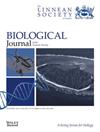How rugose can you go? Spiny Agonidae armour decreases boundary layer separation
IF 2
3区 生物学
Q3 EVOLUTIONARY BIOLOGY
引用次数: 0
Abstract
Armour has been present in vertebrates for millions of years and has evolved independently several times in the ray finned fishes. While armour is typically considered defensive, it is a multifunctional trait with many plausible alternative functions. We explore the hydrodynamic function of armour in nine species of poachers (Agonidae) by visualizing flow to assess drag reduction. We used microcomputed tomography scans to categorize armour morphology into morphotypes, and compared the rugosity (surface roughness) across these morphotypes. We then used digital particle image velocimetry to visualize boundary layer separation along 3D-printed whole-body models made using the scans. Poacher armour comprises eight rows that, some distance behind the second dorsal fin, merge into six. We found four morphotypes, with higher rugosity observed for the prominent spine morphotype and the lowest rugosity in the no-spine morphotype. Principal component analysis revealed that much of the variation in armour morphology is driven by plate shape, spine size, and protrusion. The boundary layer was retained longer in species with larger spines. Overall, the presence of a spine increased boundary layer retention, decreasing the drag, which is advantageous for these benthic fish.你能有多崎岖不平?带刺的龙鳞甲减少了边界层的分离
脊椎动物的铠甲已经存在了数百万年,并在鳐鱼类中独立进化了数次。虽然铠甲通常被认为是防御性的,但它是一种多功能特征,具有许多似是而非的替代功能。我们通过可视化流动来评估阻力的减少,从而探索九种偷猎者(鮟鱇科)鳞甲的流体力学功能。我们利用微计算机断层扫描将铠甲形态分为不同的形态类型,并比较了这些形态类型的凹凸度(表面粗糙度)。然后,我们使用数字粒子图像测速仪来观察利用扫描结果制作的三维打印全身模型的边界层分离情况。偷猎者的鳞甲由八排组成,在第二背鳍后方一段距离处合并为六排。我们发现了四种形态类型,其中突出脊柱形态类型的凹凸度较高,而无脊柱形态类型的凹凸度最低。主成分分析表明,鳞甲形态的变化主要受板块形状、棘大小和突出程度的影响。在棘刺较大的物种中,边界层保留的时间较长。总体而言,刺的存在增加了边界层的保留,减少了阻力,这对这些底栖鱼类是有利的。
本文章由计算机程序翻译,如有差异,请以英文原文为准。
求助全文
约1分钟内获得全文
求助全文
来源期刊
CiteScore
4.30
自引率
10.50%
发文量
140
审稿时长
3-6 weeks
期刊介绍:
The Biological Journal of the Linnean Society is a direct descendant of the oldest biological journal in the world, which published the epoch-making papers on evolution by Darwin and Wallace. The Journal specializes in evolution in the broadest sense and covers all taxonomic groups in all five kingdoms. It covers all the methods used to study evolution, whether whole-organism or molecular, practical or theoretical.d.

 求助内容:
求助内容: 应助结果提醒方式:
应助结果提醒方式:


